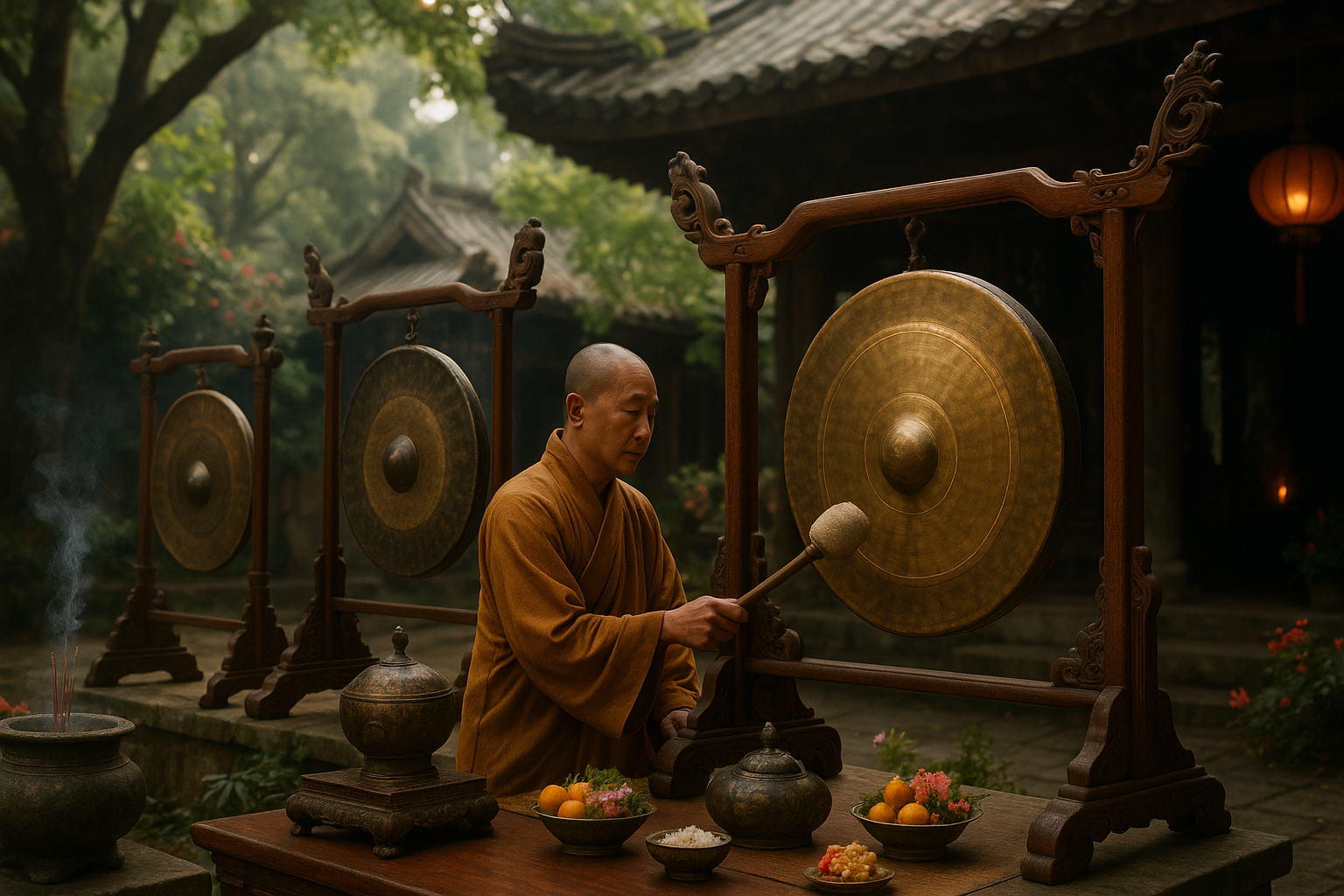In the heart of Asia, where ancient traditions meet the whispers of modernity, there exists an instrument that transcends time and space: the gong. With its deep, resonant tones, the gong is not merely a musical instrument but a powerful conduit for spiritual and cultural expression. This blog post delves into the sacred role of gongs in Asian ritual practices, a journey that promises to reveal the profound connection between sound, spirituality, and cultural identity. 🌏
Across the diverse landscapes of Asia, from the tranquil temples of Thailand to the vibrant festivals of Indonesia, the gong plays a pivotal role in rituals that have been preserved through millennia. Its sound is said to harmonize the mind, body, and spirit, creating a space where individuals can connect with the divine. But how did this seemingly simple instrument come to hold such profound significance?
In our exploration, we will traverse the rich tapestry of Asian history and tradition to uncover the origins of the gong and its evolution over time. We’ll examine how different cultures have adapted its use to suit their unique spiritual needs and how these practices continue to resonate in contemporary society.
The journey begins with an exploration of the gong’s origins, believed to date back thousands of years. We’ll delve into the legends and historical records that trace the gong’s journey from a practical tool to a sacred object, revered by shamans and monks alike. Understanding this transformation is key to appreciating its role in ritualistic practices today.
Next, we’ll delve into the specific ways in which gongs are used in rituals across various Asian cultures. In China, the gong is integral to Buddhist ceremonies, where its sound is believed to purify the mind and ward off evil spirits. In contrast, the Balinese use gongs in their traditional gamelan ensembles, where the music creates a soundscape that facilitates communication with the divine. Each cultural context offers a unique perspective on the gong’s spiritual significance, illustrating the diversity and richness of Asian ritual practices.
One cannot discuss the sacred role of gongs without addressing the profound psychological and physiological effects of their sound. Studies have shown that the vibrations produced by gongs can induce a meditative state, reducing stress and promoting emotional healing. This aspect of gong use highlights a fascinating intersection between ancient wisdom and modern science, offering insights into why these instruments have endured as tools for spiritual growth.
Furthermore, we’ll explore how the role of gongs has evolved in contemporary settings. With the rise of global interest in wellness and meditation, gongs have found a place in yoga studios and mindfulness retreats worldwide. This modern adoption not only preserves ancient traditions but also adapts them to meet the spiritual needs of a global audience.
The final section of our exploration will reflect on the future of gongs in ritual practices. As technology advances and cultural exchanges become more prevalent, how will the role of gongs in spiritual practices evolve? Will these ancient instruments maintain their sacred status, or will they be transformed by new interpretations and uses?
Throughout this article, we aim to provide a comprehensive and engaging exploration of the gong’s sacred role in Asian ritual practices. By examining its historical roots, cultural significance, psychological impact, and modern adaptations, we hope to offer readers a deeper understanding of why this instrument continues to resonate so powerfully in both traditional and contemporary contexts.
Join us on this auditory journey, as we uncover the harmonious blend of sound and spirituality that defines the gong’s place in Asian rituals. Whether you are a seasoned practitioner of meditation or simply curious about cultural traditions, this exploration promises to enrich your appreciation for the timeless power of sound in shaping human experience. 🎶

Resonating Harmony: Exploring the Sacred Role of Gongs in Asian Ritual Practices
Conclusion
In delving into the mesmerizing world of gongs and their profound impact on Asian ritual practices, we have journeyed through a rich tapestry of history, culture, and spirituality. Throughout this article, we’ve uncovered the deep-rooted significance of gongs, tracing their origins and exploring how they continue to resonate within various cultural contexts across Asia.
First and foremost, we explored the historical roots of gongs, revealing their ancient beginnings and the evolution of their craftsmanship. These instruments, often crafted with meticulous attention to detail, have transcended their utilitarian purposes to become sacred artifacts used in spiritual ceremonies. The art of gong-making itself is an age-old tradition, passed down through generations, preserving cultural heritage and sustaining local communities.
Furthermore, our exploration took us into the spiritual realm, where gongs serve as conduits between the earthly and the divine. They play a pivotal role in rituals aimed at healing, meditation, and transformation. The reverberations of gongs are believed to purify spaces, elevate spiritual consciousness, and facilitate a deeper connection to the self and the universe. 🕉️ This sacred sound therapy is not only revered for its spiritual benefits but is increasingly being recognized for its therapeutic applications in modern wellness practices.
In addition, we examined the diverse cultural adaptations of gongs across Asia. From the grand temples of Thailand to the serene monasteries of Tibet, the gong takes on various forms and functions, each uniquely integrated into local customs and beliefs. This adaptability underscores the gong’s ability to unify and harmonize diverse cultures, fostering a sense of community and shared identity. 🌍
Importantly, the article highlighted the ongoing relevance of gongs in contemporary society. As the world becomes more interconnected, the gong’s timeless sound continues to captivate and inspire global audiences. Its use in music, art, and personal development workshops exemplifies how traditional practices can adapt to modern contexts, offering new pathways for cultural exchange and understanding.
In conclusion, the study of gongs in Asian ritual practices is a testament to the enduring power of cultural traditions to inspire and transform. These resonant instruments are much more than just musical tools; they are symbols of harmony, peace, and spiritual awakening. The gong invites us to pause, listen, and reflect, opening our hearts to new dimensions of experience.
We encourage you, dear reader, to further explore this fascinating subject and consider how the timeless wisdom of gongs might enrich your own life. Whether through attending a sound meditation session or simply sharing this article with friends and family, you can contribute to the preservation and appreciation of this sacred tradition. 🔔✨
Join the conversation by leaving a comment below. We’d love to hear your thoughts on the role of gongs in cultural and spiritual practices. Additionally, feel free to share this article with others who might find it as enlightening as you did. Let us spread the harmonious vibrations of this ancient art form far and wide. Together, let’s celebrate the universal language of sound and its power to connect us all. 🌐🎶
Toni Santos is a cultural storyteller and food history researcher devoted to reviving the hidden narratives of ancestral food rituals and forgotten cuisines. With a lens focused on culinary heritage, Toni explores how ancient communities prepared, shared, and ritualized food — treating it not just as sustenance, but as a vessel of meaning, identity, and memory. Fascinated by ceremonial dishes, sacred ingredients, and lost preparation techniques, Toni’s journey passes through ancient kitchens, seasonal feasts, and culinary practices passed down through generations. Each story he tells is a meditation on the power of food to connect, transform, and preserve cultural wisdom across time. Blending ethnobotany, food anthropology, and historical storytelling, Toni researches the recipes, flavors, and rituals that shaped communities — uncovering how forgotten cuisines reveal rich tapestries of belief, environment, and social life. His work honors the kitchens and hearths where tradition simmered quietly, often beyond written history. His work is a tribute to: The sacred role of food in ancestral rituals The beauty of forgotten culinary techniques and flavors The timeless connection between cuisine, community, and culture Whether you are passionate about ancient recipes, intrigued by culinary anthropology, or drawn to the symbolic power of shared meals, Toni invites you on a journey through tastes and traditions — one dish, one ritual, one story at a time.




